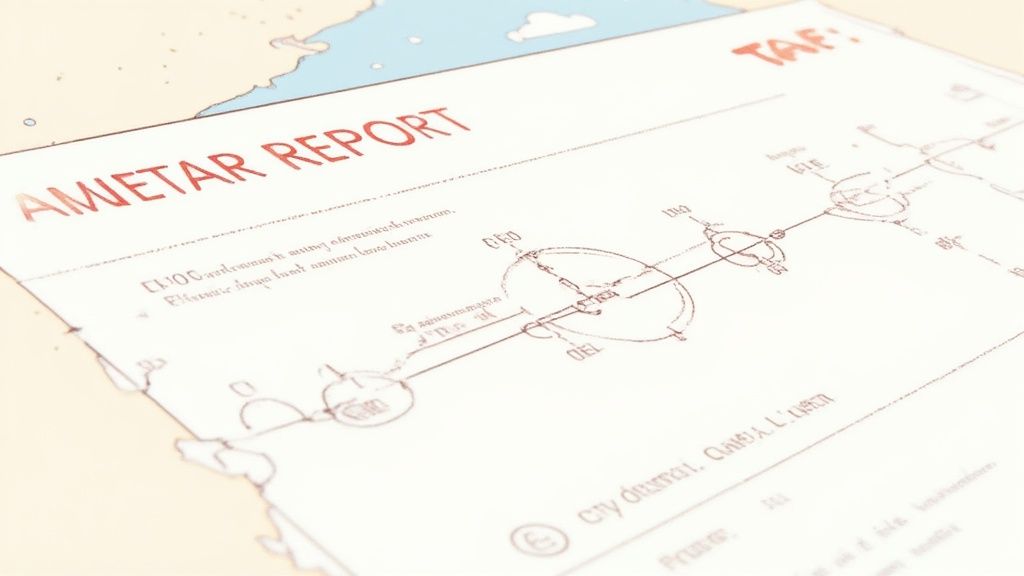Why Pilot Weather Briefing Makes All the Difference
Weather is a powerful force in aviation. It can quickly change a smooth flight into a challenging one. A thorough pilot weather briefing isn’t just a regulatory requirement; it’s a critical tool for making decisions that directly affect flight safety and outcomes. Understanding the weather is paramount for a safe flight.
The Impact of Weather on Flight Safety
Talking with veteran pilots and accident investigators reveals countless stories where a comprehensive weather assessment prevented potential disasters. There’s a clear link between thorough briefings and fewer weather-related incidents. This proactive approach helps pilots make informed decisions, often before they even enter the cockpit. These briefings aren’t just about avoiding thunderstorms; they’re about understanding the overall weather picture and how it might change during the flight.
This proactive approach empowers pilots to make informed go/no-go decisions. In addition, planning for alternate airports increases flight safety by giving pilots flexibility if the weather suddenly changes.
Different Approaches to Weather Briefings
Different segments of aviation, from weekend flyers to commercial airline captains, approach weather briefings with different levels of detail, but the core principles remain the same. A seasoned airline pilot might use sophisticated software to analyze jet stream patterns, while a private pilot planning a local flight will concentrate on more localized conditions. Both, however, understand the importance of accurate and timely information.
Pilot weather briefings are crucial, particularly in areas known for unpredictable weather. They contribute significantly to global aviation safety. According to the International Air Transport Association (IATA), weather is the main reason for airline flight delays, causing roughly 65% of delays in the U.S. and about 40% globally. In the European Aviation Safety Agency (EASA) region, weather-related incidents make up almost 20% of reported safety occurrences each year. These statistics demonstrate the critical need for timely and accurate pilot weather briefings. Explore this topic further here.
Legal Aspects of Weather Briefings
Finally, every pilot must understand the legal requirements for weather briefings. Regulations mandate certain actions and documentation to maintain accountability and adherence to safety standards. Not following these rules can result in penalties and compromise flight safety. These regulations emphasize how vital weather is to aviation. By understanding both the practical and legal parts of weather briefings, pilots can confidently fly, prepared to make informed choices that prioritize safety and efficiency.
The Digital Revolution in Pilot Weather Intelligence
The way pilots access and interpret weather information has changed dramatically. Instead of relying on paper charts and in-person briefings, pilots now utilize dynamic, interactive weather platforms. This shift represents a significant advancement in pilot weather briefing.

From Paper to Pixels: A New Era of Weather Briefings
For decades, printed weather reports, often supplemented by discussions with flight service specialists, were the primary sources of weather information. This process could be slow and prone to human error. Today, digital tools deliver current data directly to pilots, both during pre-flight planning and while in the cockpit. This readily available information empowers pilots to make more informed decisions.
You might also be interested in: How to read sectional charts.
The Impact of Electronic Flight Bags (EFBs)
The introduction of Electronic Flight Bags (EFBs) has been especially impactful. EFBs provide a central platform for accessing charts, maps, and real-time weather information, eliminating bulky paper manuals. This streamlined approach reduces the risk of overlooking crucial data and improves overall situational awareness. Furthermore, EFBs can integrate with other cockpit systems, presenting a comprehensive picture of the flight environment.
The evolution from paper to digital weather briefings is a substantial advancement for aviation safety. Before the 1990s, pilots relied heavily on printed materials and face-to-face briefings. In 1995, only about 12% of general aviation pilots used automated weather briefing systems. By 2020, that number had jumped to over 90%. The rise of digital EFBs and online briefing tools like Pilotbrief and Flight Service now gives pilots real-time weather, radar, satellite, and airspace information directly in the cockpit.
This digital transformation hasn’t only improved situational awareness; it’s reduced weather-related accidents. Studies indicate a 30% drop in such accidents in the U.S. between 2000 and 2020, thanks largely to improved access to weather data. This transition has also fostered better collaboration, allowing dispatch and flight crews to share the same weather intelligence, ultimately contributing to safer, more efficient operations. Find more detailed statistics here.
The Power of Real-Time Data and Enhanced Training
Access to real-time weather data allows pilots to monitor developing weather systems and make necessary adjustments to their flight plans. For instance, a pilot can now readily identify areas of potential turbulence or wind shear and make informed decisions to avoid them. However, this wealth of information requires enhanced training. Pilots now need to be proficient in interpreting complex data from multiple sources to make sound judgments based on available information. This ongoing development in training contributes to improved flight safety.
Anatomy of a Complete Pilot Weather Briefing
A complete pilot weather briefing involves much more than just checking the METAR and TAF. It requires understanding the complex interactions of weather elements and their potential impact on your flight. This understanding is crucial for safe and informed decision-making.

Understanding the Big Picture: Area Forecasts
Area Forecasts provide a broad overview of weather conditions across a large region. They are the foundation of your weather briefing, giving you the “big picture.” Area forecasts cover general conditions such as cloud cover, visibility, precipitation, and winds aloft. This information sets the stage for understanding more localized reports.
Localized Details: Terminal Area Forecasts (TAFs)
Terminal Area Forecasts (TAFs) offer more specific predictions for individual airports. These forecasts usually cover a 24-32 hour period. TAFs include information on wind shear, significant weather changes, and temporary conditions, helping you anticipate the weather at your departure and arrival airports.
Real-Time Updates: Meteorological Aerodrome Reports (METARs)
Meteorological Aerodrome Reports (METARs) deliver current, observed weather conditions at an airport. These reports are updated hourly, or more frequently if conditions change rapidly. METARs provide a snapshot of current temperature, dew point, visibility, wind, and precipitation – a real-time check on the TAF’s accuracy.
Pilot Reports: Real-World Conditions (PIREPs)
Pilot Reports (PIREPs) offer real-time insights from pilots already in the air. These reports detail actual in-flight conditions, such as unexpected turbulence, icing, or wind shear. PIREPs can fill the gaps in official forecasts, providing information not available elsewhere.
Graphical Forecasts: Visualizing the Weather
Graphical forecasts enhance your understanding beyond text-based reports. Radar imagery depicts precipitation intensity and movement. Satellite images offer a broader view of cloud cover and weather systems. These visuals help contextualize text reports. Instead of just reading about a storm, you can see its size and movement.
The following table outlines the essential weather products and information sources that comprise a complete pilot weather briefing, including their purpose, update frequency, and interpretation considerations.
| Weather Product | Purpose | Update Frequency | Key Information Provided | Interpretation Considerations |
|---|---|---|---|---|
| Area Forecasts (FA) | Provide a general overview of weather conditions over a large region. | Issued 3 times daily. | Cloud cover, visibility, precipitation, winds aloft. | Provides the “big picture” for pre-flight planning. |
| Terminal Aerodrome Forecasts (TAF) | Detailed forecast for a specific airport. | Issued 4 times daily. | Wind, visibility, weather, cloud cover, obstructions to vision, wind shear. | Crucial for anticipating conditions at departure and arrival airports. |
| Meteorological Aerodrome Report (METAR) | Current observed weather at a specific airport. | Typically hourly or as conditions change. | Temperature, dew point, wind, visibility, precipitation, cloud cover, altimeter setting. | Real-time snapshot of conditions; compare with TAF. |
| Pilot Reports (PIREP) | Real-time reports from pilots in flight. | As needed, when pilots encounter significant weather. | Turbulence, icing, wind shear, other unexpected conditions. | Fills in gaps in official forecasts; valuable for situational awareness. |
| Radar Imagery | Depicts precipitation intensity and movement. | Updated frequently, often every few minutes. | Location, intensity, and movement of precipitation areas. | Essential for avoiding thunderstorms and other hazardous precipitation. |
| Satellite Imagery | Provides a large-scale view of cloud cover and weather systems. | Updated regularly, typically every hour or less. | Cloud patterns, weather system development and movement. | Helps visualize the overall weather situation and forecast trends. |
This table summarizes the key weather products used in pilot briefings. Each product offers unique insights, and integrating them builds a comprehensive weather picture.
Integrating Weather Information: A Comprehensive Approach
A thorough briefing combines these information sources. This lets you anticipate hazards and adjust your flight plan. It involves recognizing patterns and making decisions based on the most complete data. Remember, safe flying starts with a solid understanding of the weather.
Digital Tools That Transform Pilot Weather Briefing
Pilots today have a wealth of digital resources at their fingertips for weather briefings. However, sifting through the sheer volume of information can be a challenge. This section will explore some of the most valuable platforms available and discuss strategies for ensuring access to critical weather data, even when technology fails.

Essential Platforms for Pilot Weather Briefings
Several key platforms have become indispensable for obtaining and interpreting weather information. These include ForeFlight, Garmin Pilot, and official FAA resources. Each platform offers distinct advantages.
ForeFlight is renowned for its user-friendly interface and powerful data visualization capabilities. Garmin Pilot integrates seamlessly with Garmin avionics, streamlining the cockpit experience. Official FAA resources provide authoritative weather products directly from the source. For further insights into how Electronic Flight Bags (EFBs) simplify pilot workflows, check out this helpful resource: How EFBs simplify pilot workflows.
Thorough flight planning is essential for safe and efficient operations. Numerous factors need to be considered, and resources like UAV Flight Planning can offer valuable guidance.
To help you compare various platforms, we’ve compiled the following table:
Comparison of Popular Pilot Weather Briefing Platforms
This table compares the features, pricing, and capabilities of leading weather briefing platforms used by pilots, helping readers choose the right solution for their needs.
| Platform | Cost | Key Features | Mobile Capability | Integration Options | Best For |
|---|---|---|---|---|---|
| ForeFlight | Subscription | Comprehensive data visualization, intuitive interface, route planning | iOS, Android | Integrates with various avionics systems | Pilots of all levels, especially those who value user experience and detailed data |
| Garmin Pilot | Subscription | Seamless integration with Garmin avionics, flight planning, traffic awareness | iOS, Android | Strong integration within the Garmin ecosystem | Pilots flying with Garmin avionics who want a tightly integrated solution |
| FAA Resources (1800wxbrief, Aviation Weather Center) | Free | Authoritative weather products, regulatory information, notices to airmen | Web-based, mobile-friendly | Limited direct integration, but data can be used in other platforms | All pilots, especially for pre-flight briefings and accessing official information |
Remember to research each option fully to determine the best fit for your individual needs.
Integrating Tools for Seamless Workflows
Effective pilots don’t rely on a single tool. They integrate multiple platforms across their devices for streamlined pre-flight planning and in-cockpit updates. This could involve synchronizing flight plans between a tablet and an EFB or using a mobile app for quick weather checks. These practices contribute to efficient and informed decision-making.
Redundancy: Ensuring Backup Weather Information
What if your primary EFB malfunctions mid-flight? Redundancy is paramount. Prepared pilots have backup plans for accessing weather data. This could be a second device, printed briefings, or knowing how to contact Flight Service via radio. Such preparedness guarantees access to critical weather intelligence.
Impact of Improved Weather Briefings
Real-time weather data has significantly improved pilot weather briefings. The FAA gathers data from the National Weather Service (NWS), combining it with radar, satellite, and surface reports. This gives pilots a comprehensive and up-to-the-minute understanding of weather conditions. In 2022, over 1,400 weather events globally disrupted flights. However, improved briefing tools have decreased weather-related disruptions like go-arounds, diversions, and cancellations by nearly 15% in the last ten years. As the aviation industry modernizes, with over 12,000 new commercial aircraft anticipated between 2023 and 2030, the need for these advanced solutions will continue to grow. For deeper insights, read the full research here.
Emerging Technologies in Pilot Weather Briefings
The evolution of pilot weather briefing is ongoing. Emerging technologies, such as artificial intelligence and machine learning, offer exciting possibilities. These technologies are being integrated into weather models and briefing platforms. They hold the promise of even more precise forecasts and personalized weather information. For instance, AI could analyze a pilot’s intended route and provide specific alerts tailored to their aircraft type.
Translating Weather Data Into Flight Decisions
Interpreting weather data is a multifaceted skill, influenced by the aircraft type, flight purpose, and individual pilot’s minimums. This section explores how weather information is applied to real-world flight scenarios, illustrating how experienced pilots adapt their decision-making process.

Tailoring Your Approach Based on Flight Type
Weather analysis varies significantly depending on whether you’re flying under Visual Flight Rules (VFR) or Instrument Flight Rules (IFR). VFR flight depends on clear visibility, making pilots particularly sensitive to cloud cover, fog, and other visibility limitations. IFR flight, on the other hand, allows flight in instrument meteorological conditions but introduces challenges related to icing, turbulence, and complex airspace navigation. Seemingly minor changes in conditions can have a substantial impact on both VFR and IFR flights.
For instance, a VFR pilot planning a short flight on a clear day primarily focuses on local conditions like wind and visibility. A pilot preparing for a cross-country IFR flight, however, must analyze a wider range of data. This includes winds aloft, icing forecasts, and potential turbulence along the route. Pilots frequently use digital tools and resources, such as the Top API Documentation Generator Tools of 2025, for weather briefings.
Altitude Considerations in Weather Interpretation
Altitude is another key factor in weather analysis. Low-altitude flights are more susceptible to terrain-induced turbulence, requiring careful consideration of obstacles and microclimates. High-altitude flights present different challenges, like jet stream winds and the possibility of clear-air turbulence. For further insights, explore our article on Aeronautical Decision Making.
Analyzing Weather Products for Effective Decision Making
Real-world weather products significantly influence pilot decisions. Consider a scenario with two pilots reviewing the same Terminal Aerodrome Forecast (TAF). One pilot, observing a forecast for marginal VFR conditions at the destination, may choose to delay the flight. The other pilot, with a higher risk tolerance and an aircraft equipped for instrument approaches, might proceed, ready to divert if conditions worsen. This highlights how the same information can lead to different, yet valid, decisions.
Developing Pattern Recognition Skills
Over time, experienced pilots develop a keen sense for interpreting weather, spotting subtle indicators that might be missed by less experienced pilots. This ability stems from consistently analyzing weather charts, reading Pilot Reports (PIREPs), and understanding atmospheric interactions. A veteran pilot might, for example, recognize a particular cloud formation suggesting imminent turbulence, even if not explicitly mentioned in the forecast.
Real-World Examples of Weather Interpretation
Example 1: A pilot preparing for a mountain flight checks the winds aloft and observes a strong crosswind at ridge level. Recognizing the potential for dangerous turbulence, they can opt to fly at a lower altitude to minimize wind exposure.
Example 2: A pilot getting ready for a night flight reviews the dew point and temperature. Noticing a small temperature/dew point spread, they are able to anticipate fog and can decide to carry extra fuel in case a diversion is necessary.
These examples demonstrate how even slight variations in data interpretation can significantly impact flight outcomes. A strong understanding of weather principles, along with consistent practice, contributes to becoming a safer and more knowledgeable pilot.
The Pilot Weather Briefing System That Actually Works
Up next is a practical, step-by-step guide to effective pilot weather briefings, honed over numerous successful flights. We’ll explore a systematic approach ensuring you gather all crucial information without feeling overwhelmed. This system helps pilots of all skill levels confidently make weather-related decisions.
Scaling Your Briefing to the Situation
Your briefing process should always match the specifics of each flight. A short hop on a familiar route might only need a quick look at current conditions. But a longer flight, especially one crossing through different weather systems, demands a much deeper dive.
Knowing how to tailor your approach is key. A quick local flight in good weather might only require checking the METAR and TAF for departure and arrival airports. On the other hand, a cross-country flight needs a review of Area Forecasts, winds aloft, and significant weather charts.
For a deeper look at flight planning, check out our article on How to master flight planning.
Avoiding Shortcuts and Maintaining Thoroughness
Some briefing shortcuts have unfortunately contributed to incidents. One common error is depending only on automated briefings without a careful review of the actual data.
For instance, a pilot could miss a vital PIREP about unexpected turbulence simply because it wasn’t highlighted in the automated summary. Even when time is tight, a systematic approach is essential. Create a checklist of key items to review, guaranteeing you don’t overlook crucial details.
Documentation: Creating In-Flight References
Proper documentation not only fulfills regulatory requirements but also provides helpful in-flight references. Record important weather details from your briefing, such as forecasts, NOTAMs, and PIREPs.
This allows quick access to important information during the flight, boosting situational awareness. This record can be a simple written note or screenshots of important charts.
Ongoing Weather Monitoring for Continuous Awareness
A pilot weather briefing isn’t a one-and-done pre-flight task. Think of it as the start of ongoing situational awareness. During your flight, regularly check for weather updates.
Use in-cockpit systems, radio broadcasts, or datalink weather. Staying on top of changing conditions lets you proactively adjust your flight plan. This transforms the briefing from a static pre-flight chore into a dynamic tool for improved safety throughout your flight. This structured approach encourages thoroughness and flexibility, resulting in more informed and safer flight decisions.
By being systematic, avoiding risky shortcuts, documenting important information, and continuously monitoring weather, pilots increase their safety margins and contribute to a more informed and proactive aviation environment.
Recent Posts
FAA MOSAIC Final Rule: What Pilots, Manufacturers, and the Aviation Community Need to Know
Learn how the FAA’s MOSAIC final rule revolutionizes Light-Sport Aircraft certification, expands Sport Pilot privileges, and reshapes general aviation. See what’s changing, when it takes effect,...
Student Pilot Insurance: Essential Coverage for Aspiring Flyers
Discover how student pilot insurance can protect your flying dreams. Get expert tips and coverage options to ensure your safety and peace of mind.


